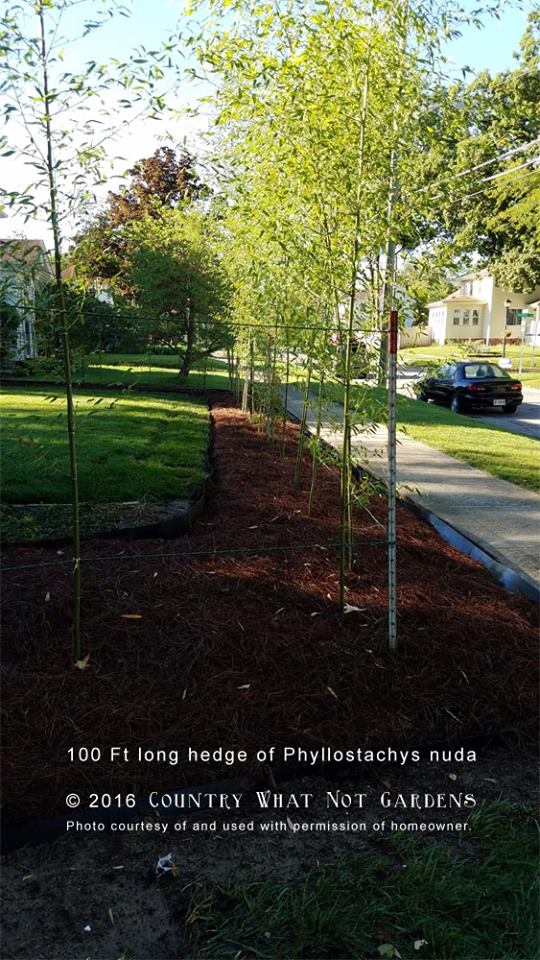Installing a bamboo barrier properly is important to its successful control.
When possible we always recommend natural containment methods.
• Mowing a swath of lawn 25′ to 30′ or more around all sides of the bamboo grove.
• Edging around the grove with a flat blade spade in a pattern of overlapping cuts all the way around the grove once or twice every year.
• Planting on an island in a pond since bamboo won’t cross water.
• Planting in a raised bed 14″ high. Preferably with a thick concrete patio under it.
These methods aren’t always possible or practical. When these methods won’t work for your particular application that leaves in-ground barriers as your option.
These in-ground barriers are made of HDPE (High Density Polyethylene).
This barrier comes in rolls of various widths from 24″ to 36″ inches. Thicknesses also vary from 60 to 100 mil.
We do not sell bamboo barrier, but we recommend this barrier as a minimum size and thickness. Wider and heavier duty is of course better.
For the larger Phyllostachys species you will want enclose an area at least 10′ to 15′ in diameter, or the square foot equivalent, for them to reach their full potential.
When installing a barrier you will need to dig a trench 2″ shallower than your barrier is wide. So a 36″ barrier needs a 34″ deep trench. There should be 2″ of barrier remaining above ground when you’re finished. This helps to prevent the rhizomes from jumping the barrier and entering the ground on the other side.
When you’re digging the trench make sure that there are no hard surfaces near where the barrier will be under ground. The barrier will expand somewhat with the pressure of the bamboo roots growing against it.
There should be no tree roots, rocks, cement sidewalks or foundations, fence posts, or any other hard surface that will contact the underground barrier. Any pressure against these surfaces will create a stress point where the barrier could rupture and fail.
Preventing stress points is very important. Another way to eliminate stress points is to never install a barrier with a sharp bend. Sharp bends or corners will be another stress point. Alway install a bamboo barrier with broad sweeping curves and no corners.
The barrier should slope slightly outwards away from the planting bed on all sides at the top. This funnel shape helps to divert the rhizomes upwards and out of the barrier as they grow. They can then be clipped off and removed.
Once the barrier is in position the ends should be joined together to form a completely enclosed planting area.
Many barrier suppliers supply tape for joining the ends together. We recommend using stainless steel strip clamps if you can find them.
These consist of two strips of stainless steel with holes drilled in them. One metal strip goes on one side of the barrier and another goes opposite the first strip. The holes of each strip should line up through the barrier and with the strip on the other side.
Stainless steel bolts go through the first strip, through holes drilled in the barrier, through the holes of the strip on the other side, and are fastened with stainless steel nuts.
We recommend overlapping the ends of the barrier by 7.5″ if using the stainless steel clamps. The clamp goes in the middle of this overlap and gives you about 3″ of overlap after the clamp on each side of the barrier.
If you have to use tape to join the barrier, follow the manufacturer’s recommendations. Overlap can vary depending on the product used.
Once the barrier is successfully joined and positioned, backfill the trench with the soil that was removed; being sure to remove any rocks or other hard debris before using the soil to fill in around the barrier.
Maintenance –
Bamboo grown in a barrier may require supplemental watering. The soil inside the barrier is mostly walled off from the soil outside it since the bamboo barrier is only open on the bottom. The soil inside the bamboo barrier will dry out more quickly due to the root mass that it is hydrating and sustaining. Water the bamboo immediately if the soil is dry and the leaves begin to curl.
Rhizomes grow mostly during the late summer and autumn. Checking for rhizomes growing above the bamboo barrier should be a regular part of your gardening routine during this season.
Any rhizomes you find growing above this 2″ barrier lip should be cut off with garden clippers. Any rhizome clippings should be allowed to dry in the sun until dead or burned, and never thrown away in the trash where they can enter landfills while still alive.
One of the most important things is to be sure to never knick the top of the bamboo barrier with your lawnmower while mowing the lawn.
To avoid this we recommend placing a decorative edging such as a recycled rubber mulch mat around the outside edge of the barrier to act as a weed suppressant. This way you never have to mow too closely to the barrier.
